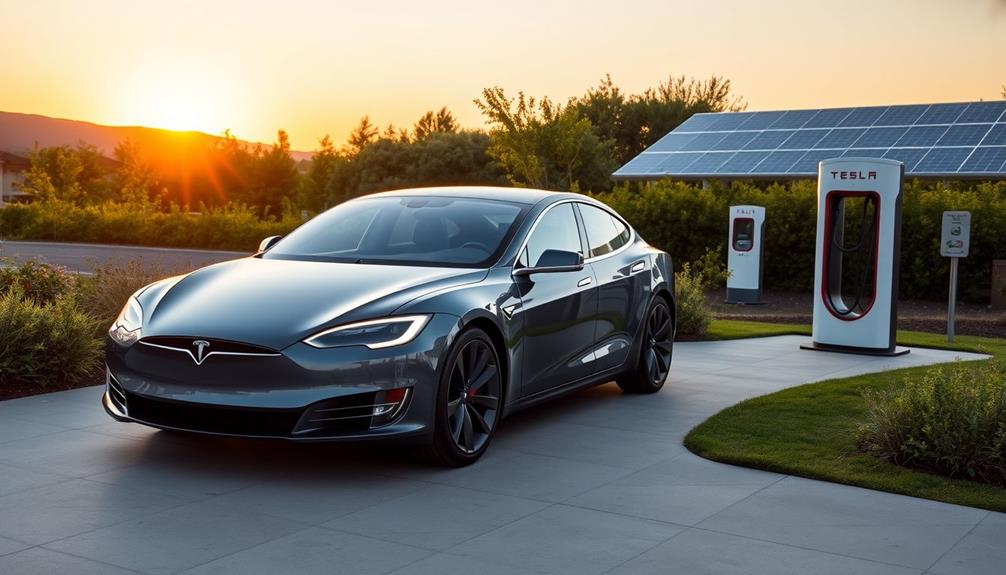The Tesla Cybertruck's price has been confirmed, and you've got some exciting options to choose from. The dual-motor variant starts at $79,990, while the high-performance Cyberbeast model costs around $100,240. If you're looking for a more affordable choice, the upcoming rear-wheel drive version is expected to be priced at $60,990. Keep in mind there are additional costs for features like the Full Self-Driving package. With competitive pricing against other electric trucks, you'll want to explore what fits your needs best. Stick around to discover more about its features and potential savings.
Key Takeaways
- The base price for the Tesla Cybertruck starts at $79,990 for the dual-motor variant.
- The high-performance Cyberbeast model is priced at approximately $100,240.
- An upcoming rear-wheel drive model is expected to cost around $60,990 in 2025.
- Additional options like the Full Self-Driving package can add $5,000 to $12,000 to the price.
- Federal tax credits of up to $7,500 may be available based on eligibility criteria.
Pricing Overview
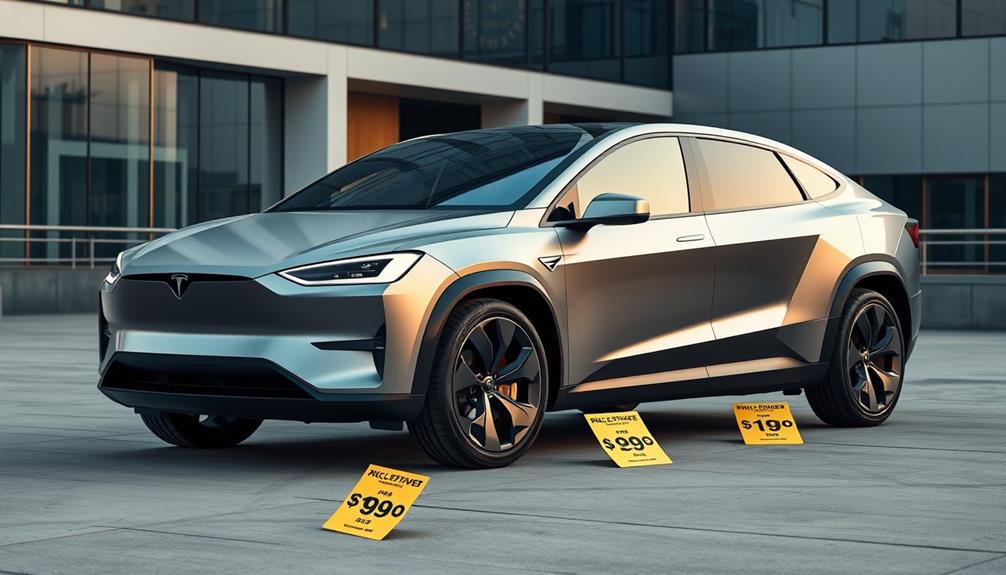
When considering the price of the 2024 Tesla Cybertruck, you'll find a range that caters to different needs and budgets. The starting price for the dual-motor variant is set at $79,990, making it a competitive option among electric trucks.
If you're looking for something more powerful, the high-performance Cyberbeast model begins at approximately $100,240.
For those on a tighter budget, the upcoming rear-wheel drive model is expected to launch in 2025 at around $60,990. Keep in mind that additional features, like the Full Self-Driving capability, can add between $5,000 and $12,000 to the final price, depending on your configuration choices.
The Cybertruck's pricing structure positions it well against rivals like the Ford F-150 Lightning and Rivian R1T, which start at approximately $50,000 and $73,000, respectively.
Plus, you might qualify for a federal tax credit of up to $7,500, depending on specific eligibility criteria. This gives you a clearer picture of the Cybertruck's price, allowing you to make an informed decision based on your budget and needs.
Model Variants and Features
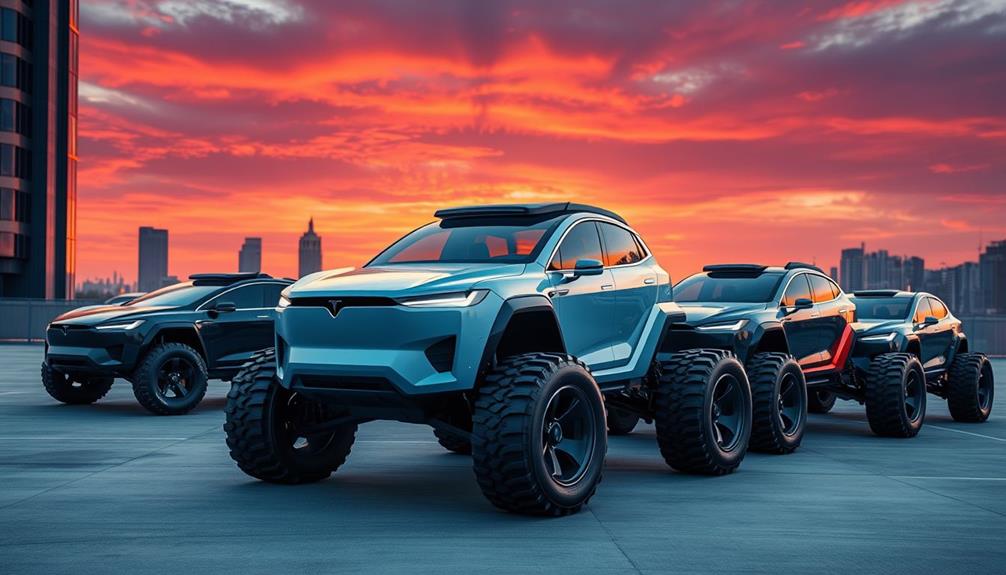
The 2024 Tesla Cybertruck offers several model variants, each designed to cater to different performance needs and preferences. The base model, the Dual Motor variant, is priced at $79,990. It provides an impressive 600 horsepower and a range of 340 miles, making it an excellent choice for everyday use. For those seeking higher performance, the Tri-Motor variant offers even more power, with 800 horsepower and a range of 450 miles, though its price climbs accordingly. Additionally, the much-anticipated Plaid version is expected to push the envelope further in terms of both speed and range. Given the excitement around these different models, Tesla Cybertruck sales so far have been strong, with preorders indicating high demand across the board.
If you're looking for something with a bit more thrill, the high-performance Cyberbeast model is your go-to, starting at $99,990, boasting 845 horsepower and an exhilarating 0-60 mph acceleration in just 2.6 seconds.
For those mindful of budget, a Rear-Wheel Drive version is expected in 2025, priced around $60,990, with a range of 250 miles. Keep in mind, the estimated total cost for a fully equipped Cybertruck can soar to about $99,990, especially with features like the Full Self-Driving suite included.
Additionally, optional upgrades like the Range Extender can enhance your range to 470 miles for an estimated cost of $16,000, allowing you to customize your Cybertruck experience further.
With these options, you'll find the perfect model to fit your lifestyle and driving preferences.
Comparison With Competitors

With the Tesla Cybertruck's impressive features and pricing, it's important to see how it stacks up against its competitors in the electric truck market.
The Cybertruck starts at $79,990, placing it higher than the Ford F-150 Lightning, which starts around $50,000, and the Chevy Silverado EV at approximately $52,000. The Rivian R1T starts at $73,000, making it a slightly more affordable option than the Cybertruck.
In contrast, the GMC Hummer EV Pickup enters the luxury segment with a price tag near $110,000. While the Cybertruck's Cyberbeast variant is priced at $100,240, it still trails behind the high-end GMC Hummer EV.
Keep in mind that all these electric trucks might qualify for potential federal tax credits, which can greatly impact their starting prices.
However, the Cybertruck is expected to boast a strong resale value due to its unique construction and features, giving it an edge over competitors like the Rivian R1T and Ford F-150 Lightning, which might experience more depreciation in this rapidly evolving electric truck market.
Tax Credit Eligibility
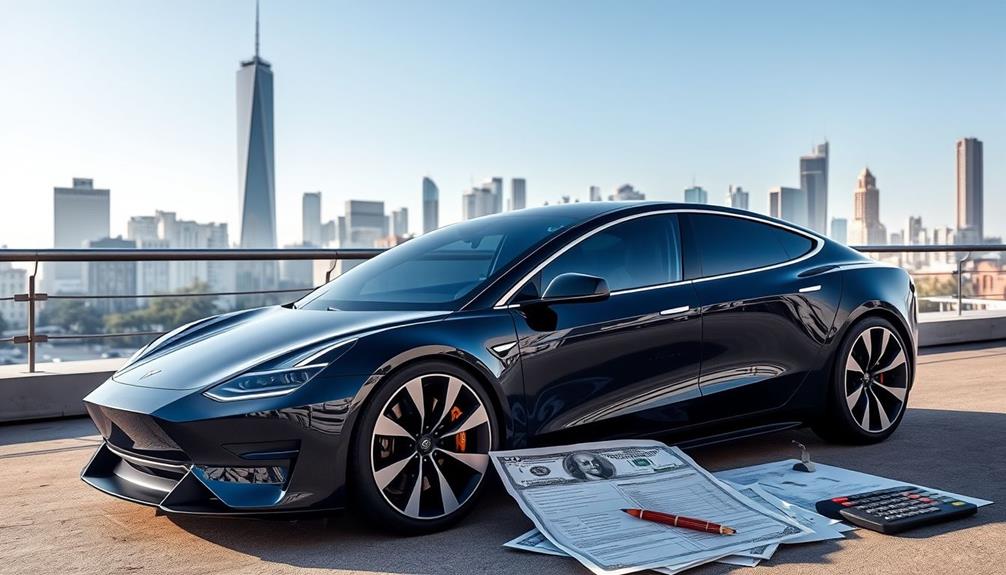
Managing tax credit eligibility can be essential for maximizing your savings on the 2024 Tesla Cybertruck. With a starting price of $79,990, the Cybertruck qualifies for potential federal tax credits of up to $7,500, provided it meets specific criteria. Since the base MSRP is under $80,000, you're already one step closer to being qualified for the federal tax credit.
However, keep in mind that there are income requirements and additional criteria that could affect your ability to claim these credits. Depending on your financial situation, you may need to do some calculations to verify you qualify.
The Cybertruck, being manufactured in Austin, Texas, also meets certain state and federal incentives aimed at promoting electric vehicle adoption, which could further enhance your savings.
To fully understand your tax credit eligibility, it's a good idea to consult resources like Kelley Blue Book. They offer up-to-date information on the Fair Purchase Price and can help you navigate the specifics of federal tax credits.
Performance and Specifications

Understanding the price and potential tax credits is just the beginning; the performance and specifications of the 2024 Tesla Cybertruck are equally impressive.
The Dual Motor variant offers a robust 600 horsepower, allowing it to accelerate from 0-60 mph in just 4.1 seconds, with an estimated range of 318 miles. If you're looking for something even more exhilarating, the high-performance Cyberbeast model delivers a staggering 845 horsepower and achieves 0-60 mph in an astonishing 2.6 seconds, topping out at 130 mph.
One of the standout features of the Cybertruck is its remarkable towing capacity of up to 11,000 pounds, positioning it as a top contender in the electric pickup market.
It's not just about power; the Cybertruck comes equipped with adaptive air suspension, allowing for a ground clearance of up to 17 inches, enhancing its off-road capabilities.
The vehicle houses a liquid-cooled lithium-ion battery pack with a generous capacity of 123.0 kWh, supporting DC fast-charging that adds 128-136 miles of range in just 15 minutes.
All these specifications make the Cybertruck a thrilling and versatile option for any driver.
Interior and Design Features
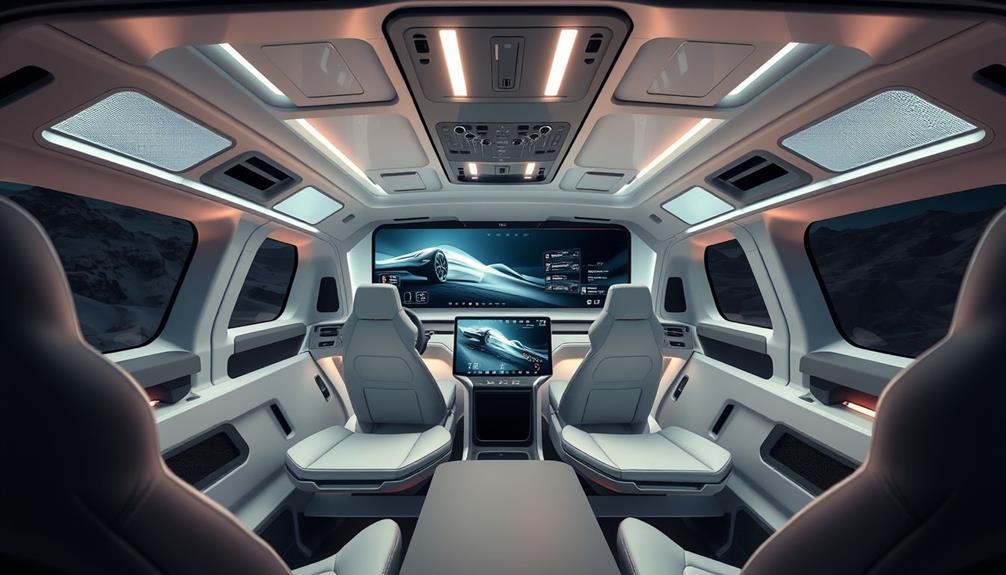
The 2024 Tesla Cybertruck stands out not just for its performance but also for its striking interior and design features. Crafted from cold-rolled stainless steel, this vehicle boasts a unique, sharp-edged body that's resistant to dents and rust. Inside, you'll find a spacious interior that accommodates up to six occupants across three rows. A central 17-inch touchscreen controls most functions, while a 9.4-inch rear passenger screen provides entertainment and climate control.
| Feature | Description | Utility |
|---|---|---|
| Seating | Seats up to six passengers | Spacious and comfortable |
| Touchscreen | 17-inch central touchscreen | Controls vehicle functions |
| Cargo Bed | 6.5-foot "vault" with 100 cubic feet storage | Lockable and secure storage |
| Durable Materials | Stainless steel construction | Resistant to dents and rust |
The Cybertruck's unibody construction enhances durability, and a large storage bin between the armrests adds utility. Additional features like on-board power outlets and a planned air compressor make it perfect for outdoor activities. With its combination of durability and thoughtful design, the Cybertruck is ready for whatever adventure you choose.
Warranty and Ownership Costs
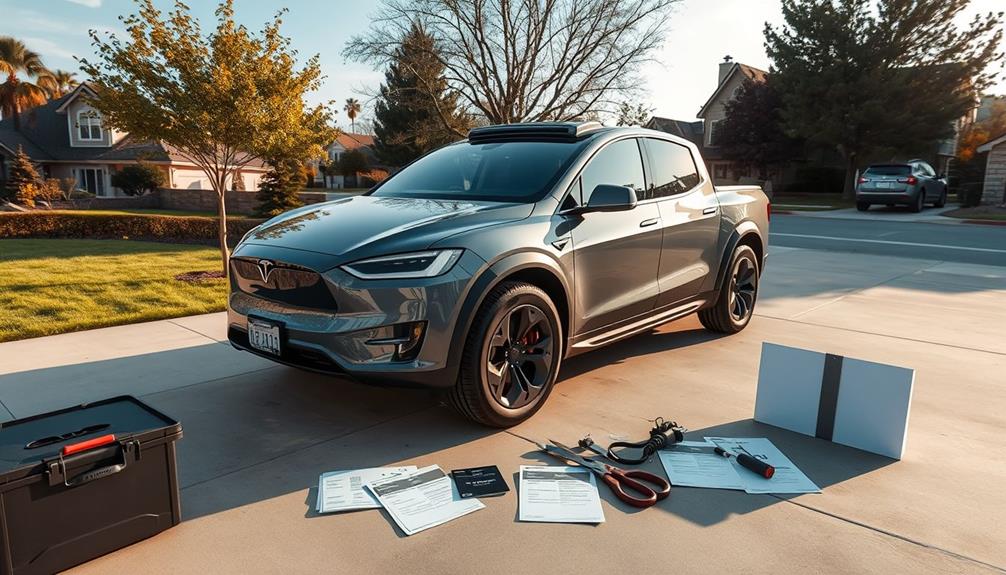
When it comes to owning a Tesla Cybertruck, knowing the warranty and ownership costs is vital for making an informed decision. The Cybertruck offers a limited warranty that covers 4 years or 50,000 miles, along with an extended powertrain warranty that lasts 8 years or 150,000 miles. This guarantees long-term coverage for essential components, including the battery, which is also backed by an 8-year or 150,000-mile warranty.
When you look at ownership costs, the estimated 5-year expenses for the Cybertruck are projected at $92,714. This figure factors in fuel, insurance, and depreciation, so it's important to take into account these elements.
With impressive fuel economy ratings of 67 MPGe in the city and 59 on the highway, your operational costs will be lower compared to traditional vehicles.
Additionally, potential federal tax credits of up to $7,500 can greatly offset some of these ownership costs, depending on your eligibility.
Customer Reviews and Ratings

Reviews for the Tesla Cybertruck are rolling in, and they paint a generally positive picture. With a consumer rating of 4.3 out of 5 based on six reviews, many potential buyers seem excited about this electric truck.
Performance ratings are particularly impressive, sitting at a remarkable 4.8. This highlights the Cybertruck's strong acceleration and handling capabilities, making it a standout choice in the electric truck market.
When it comes to styling, quality, and comfort, the Cybertruck also scores well, each receiving a rating of 4.3. This suggests that you can expect a well-designed vehicle that enhances user experience.
However, the value rating is a bit lower at 3.8, indicating some concerns about its pricing relative to perceived benefits compared to competitors.
Expert analysis reinforces the Cybertruck's appeal, showing that it excels in performance metrics compared to rival electric trucks.
Frequently Asked Questions
How Much Is the Cybertruck Going to Cost?
The Cybertruck's starting price is $79,990 for the dual-motor model. If you opt for the high-performance Cyberbeast, expect around $100,240. A rear-wheel-drive variant should arrive in 2025 for $60,990.
How Much Is the Down Payment for the Cybertruck?
When it comes to the down payment for the Cybertruck, you'll find it varies based on your chosen options. Usually, it's refundable and can change until you finalize your configuration. Keep that in mind!
What Is Monthly Payment for Cybertruck?
Your monthly payment for the Cybertruck depends on factors like your down payment, loan terms, and interest rates. Generally, expect around $1,500/month for an $80,000 loan at a 5% interest rate over 60 months.
How Much Is the Cybertruck Reservation Fee?
The reservation fee for the Cybertruck is $100. This non-refundable amount secures your spot in line, and you can adjust your configuration later, with the fee credited towards your final purchase price.
Conclusion
In conclusion, the Tesla Cybertruck's pricing and features promise to shake up the automotive landscape like a lightning bolt in a clear sky. Whether you're drawn to its unique design, impressive performance, or potential tax benefits, it's clear this vehicle stands out. As you consider your options, keep in mind how it stacks up against competitors and what ownership entails. Ultimately, the Cybertruck could redefine what you expect from an electric truck, making it a worthy investment.





